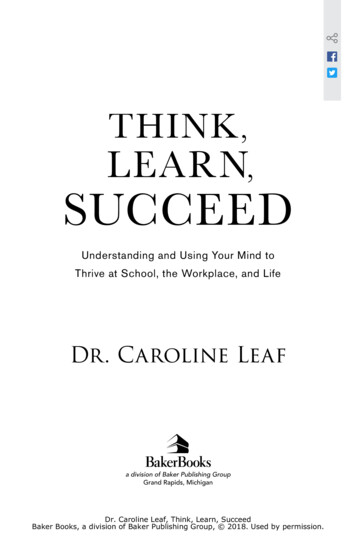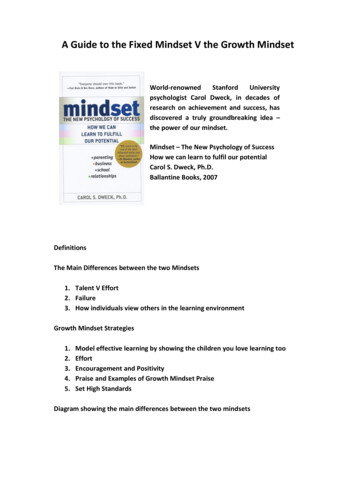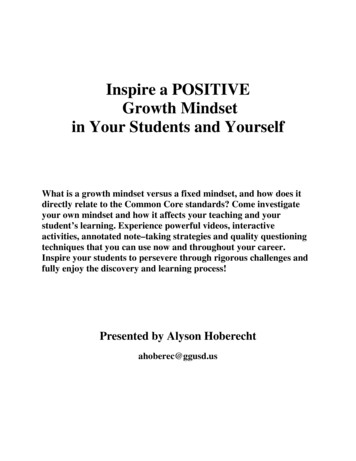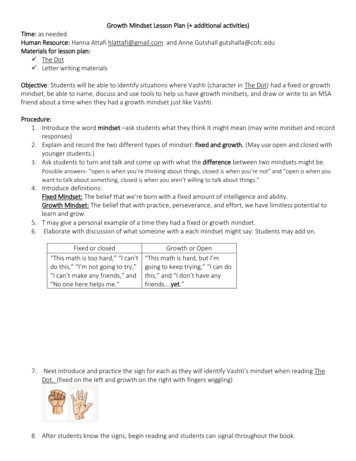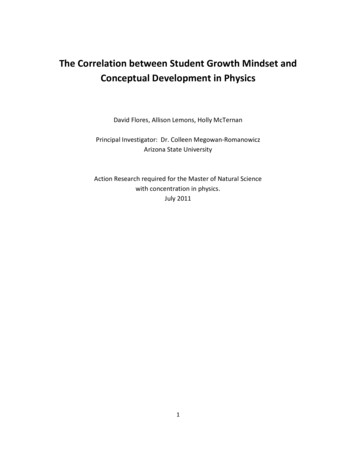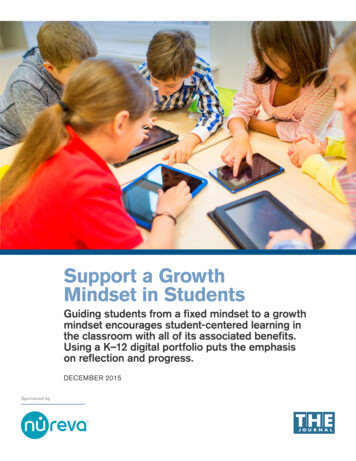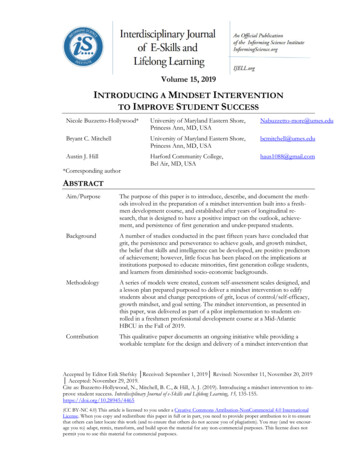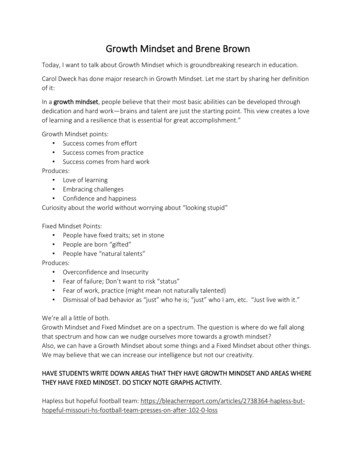
Transcription
Growth Mindset and Brene BrownToday, I want to talk about Growth Mindset which is groundbreaking research in education.Carol Dweck has done major research in Growth Mindset. Let me start by sharing her definitionof it:In a growth mindset, people believe that their most basic abilities can be developed throughdedication and hard work—brains and talent are just the starting point. This view creates a loveof learning and a resilience that is essential for great accomplishment.”Growth Mindset points: Success comes from effort Success comes from practice Success comes from hard workProduces: Love of learning Embracing challenges Confidence and happinessCuriosity about the world without worrying about “looking stupid”Fixed Mindset Points: People have fixed traits; set in stone People are born “gifted” People have “natural talents”Produces: Overconfidence and Insecurity Fear of failure; Don’t want to risk “status” Fear of work, practice (might mean not naturally talented) Dismissal of bad behavior as “just” who he is; “just” who I am, etc. “Just live with it.”We’re all a little of both.Growth Mindset and Fixed Mindset are on a spectrum. The question is where do we fall alongthat spectrum and how can we nudge ourselves more towards a growth mindset?Also, we can have a Growth Mindset about some things and a Fixed Mindset about other things.We may believe that we can increase our intelligence but not our creativity.HAVE STUDENTS WRITE DOWN AREAS THAT THEY HAVE GROWTH MINDSET AND AREAS WHERETHEY HAVE FIXED MINDSET. DO STICKY NOTE GRAPHS ACTIVITY.Hapless but hopeful football team: after-102-0-loss
Mindset Experiment Results All children in a class take a simple test and do relatively well. Then the class is divided into two groups. Group 1: ability-praised (fixed mindset) messaging: “You are a so smart!” Group 2: effort-praised (growth mindset): “You tried really hard.” Then both groups are told: “We have another simple test like the one you just took, andwe also have a more difficult test, but it will teach you more. Which one would you liketo take?”Mindset Experiment Growth Mindset Group (effort-praised):90% chose to take the harder test, and the vast majority did better than the ability-praisedstudents on the harder test. Growth Mindset Group (effort-praised): reported enjoying the difficult tests more,enjoying the more difficult problems, and wanted to take the problems home to practice. Fixed Mindset Group (work-praised):40% of those whose intelligence was praised overstated their scores to peers. “We took ordinarychildren and made them into liars,” Dweck says. Kids praised for intelligence did worse than thefirst test.Another experiment described this way:Professor Carol Dweck at Stanford University has spent twenty-five years researching howpeople’s self-concept matters in how they react to disappointment and failure. What do they dowith results they don’t like? In one of her seminal studies she gave visual IQ tests to fifth gradersand then randomly assigned what type of feedback each was given. In one treatment group thestudents were told they had performed well and were praised for their intelligence. In the othertreatment group, the students were told they had performed well and were praised for theirhard work.Next the children were given opportunities to practice different types of questions, and thestudents praised for their effort overwhelmingly picked harder problems than the studentspraised for being smart. Then Dweck’s team gave the fifth graders a seventh-grade IQ test, whichthey all bombed, but the kids praised for effort performed better than those praised for theirintelligence. This makes sense in retrospect, I suppose, given how the different groups hadpracticed. But then Dweck’s team did something especially clever: they readministered the samefifth-grade test the children had all aced earlier. Again, the effort-praised children outperformedthe intelligence-praised ones. But here is the surprising thing: the kids praised for being smartactually did worse than they had in the first round of testing. It was almost as if they had growndumber. Once they no longer believed they were smart, they weren’t.10
Please listen to the following vignette and ask yourself how it may apply to our Admissionsexams or exams you give in class. Why in our admissions process do we place such a priority onthe “heart” of the student, the mission fit of the family? For the reasons demonstrated in thisstory.From Carol Dweck: People with growth mindset know that it takes time for potential to flower.Recently, I got an angry letter from a teacher who had taken one of our surveys. The surveyportrays a hypothetical student, Jennifer, who had gotten 65% on a math exam. It then asksteachers how they would treat her.Teachers with a fixed mindset were more than happy to answer our questions. They felt that byknowing Jennifer’s score they had a good sense of knowing who she was and what she wascapable of. Their recommendations abounded. Mr. Riordan, by contrast, was fuming. Here’swhat he wrote:To Whom It May Concern:Having completed the educator’s portion of your recent survey, I must requestthat my results be excluded from the study. I feel that the study itself is scientificallyunsound Unfortunately, the test uses a faulty premise, asking teachers to makeassumptions about a given student based on nothing more than a number on apage Performance cannot be based on one assessment. You cannot determine the slopeof a line given only one point as there is no line to begin with. A single point in time doesnot show trends, improvement, lack of effort, or mathematical ability.Sincerely,Michael RiordanIt was disturbing how many teachers thought otherwise and that was the point of ourstudy. The idea that one evaluation can measure you forever is what creates the urgencyfor fixed mindset. That’s why they must succeed perfectly and immediately. Who canafford the luxury of trying to grow when everything is on the line right now.Is there another way to judge potential? NASA thought so. When they were solicitingapplications for astronauts, they rejected people with pure histories of success andinstead selected people who had significant failures and bounced back from them. JackWelch, the celebrated CEO of General Electric, chose executives on the basis of “runway”a term he used to describe their capacity for growth. And Marina Semyonova, the famousRussian ballet teacher, chose students who were energized by criticism. They were allrejecting the idea of fixed ability and selected instead for mindset.
Growth Versus Fixed Mindset1. Megan is bad at math. It’s just not something she is good at. How can I teach Meganmath in a way that connects her to the material?2. Jay can do the work but he’s just not doing it. He’s lazy. I know Jay can do the workbut he’s not doing it. I need to re-examine my approach and figure out how to engagehim.3. Mr. Jones gets all the teaching awards and accolades because he is a glory-seeker.Mr. Jones gets recognized often for his teaching. I should observe him to see if I canapply some of his strategies to my own practice.4. My students ruined this lesson. They just refused to cooperate. My students didn’tconnect with this lesson. How could I make it more engaging for them?Growth versus fixed mindset This class is filled with bad kids. I’ve heard they are completely unteachable. I willapproach this class taking each individual student into account. All students can betaught. It’s just a matter of finding the right approach. My students performed poorly on this test. Obviously, they weren’t listening. Mystudents performed poorly on this test. Obviously, I need to re-teach the material in away they will understand.Behavior- Johny interrupts in classReflective Question – Why does Johny consistently interrupt while I’m giving a lesson?Potential New Answer – Johny needs personalized supports to help him adhere to this classroompractice.An Idea for Seeking to Resolve the Issue I’ve Identified – I will work with Johny to help himidentify personalized hand cues to let him know when he is interrupting and when it is anappropriate time to share his thought.METACOGNITION STRATEGIES- THINKING JOURNALSUse prompts such as: How were you successful today in class? I know I’m learning when I’m picturing I’m wondering This reminds me of I’m feeling I’m curious How to teach Growth Mindset
In this clip please watch for various ways that children approach challenges.1. What were some of the ways that you saw different children approach challenges? Youcan see that some approach challenges with confidence- they already know they areenough. Others approach the challenge with fear because they feel that their value isbased on their accomplishment.2. What are some of the ways that you see children approach challenges in your classroom?LOU HOLZ https://www.youtube.com/watch?v 0wMmcoPTmAsHow can we teach Growth Mindset?Let’s work together on answering Carol Dweck’s question: How can we build that bridge to YET?How can we teach students growth mindset?1- Praise efforts- not ability. Teachers/adults reinforce fixed mindset with comments suchas, “You’re so smart!” where the value is based on inherent intelligence. We teachgrowth mindset when we say things like, “You worked so hard at that! I am so proud atyour effort on this. You’ll get it- maybe you’re not there yet, but you’ll get there. Don’tworry about not knowing it yet.”2- Teach students that their skills are malleable.3- Don’t rush things.4- Focus on the process.5- Create a safe environment.6- Remove the fear of failure at something- and focus on the effort, courage, vulnerabilityand other character traits that we can control.6. Make sure that students feel safe to challenge you.Middle School students- the key to learning:“There are times when you ask questions or challenge ideas, BUT if you’ve got a teacher thatdoesn’t like that or the kids in the class make fun of people who do that, it’s bad. I think that mostof us learn that it’s best to just keep your head down, your mouth shut, and your grades high.”We can’t learn when our heads are down, and our mouths are shut.How do we prevent this?Do what you can to help a student deal with shame; avoid shaming.This past summer I spent time reading the book Daring Greatly by Brené Brown. I spent timewatching her Ted Talks and pondering how we can apply some of these principles at School.
Brené Brown is a professor, lecturer and a researcher on shame and vulnerability. She studieswhat she refers to as “Wholehearted living.”Brené began her research by studying connection. As she says it, “The surest thing I took awayfrom my Bachelors, Masters and PhD in Social work is this: Connection is why we’re here. We arehardwired to connect with others, it’s what gives us purpose and meaning to our lives, andwithout it there is suffering.” She continues, “I wanted to develop research that explained theanatomy of connection.”So, she began meeting with research participants asking them about their most importantrelationships and experiences of connection, but instead they kept telling her about theirexperiences of shame, heartbreak, betrayal. They kept talking about their fear of not beingworthy of connection.Shame is the intensely painful belief that there is something about us that makes us unworthy oflove and belonging. Instead of saying, “I did something bad,” (guilt), shame says, “I AM BAD!”Through 5th grade, Shame is THE THREAT OF BEING UNLOVEABLE. In lower school, it isexperienced as trauma because you are dependent on others for food, clothing, and yoursurvival.Brene Brown- Ted Talk on Shamehttps://www.ted.com/talks/brene brown listening to shame/transcript?language enBrene Brown – Quote about shame- why it is so damagingDo I shame students without realizing it?1. A teacher has students pull a red card when they misbehave. Make efforts to preservestudent dignity by doing one-on-one coaching or conferencing. Practice privateconversations instead of public discipline.2. A teacher writes names on the board of those students who are misbehaving. Correct astudent kindly and consistently. Note the correction and deduct from the selfgovernment grade. If needed, pull them aside after class and let them know that theyreceived reduced points for class participation today.3. A student publicly disagrees with a classroom policy or an opinion you have shared inclass. You correct them and point out their error publicly. If possible, try to find areas ofagreement with the student. Empathize. If needed, privately address the student’sdisagreement with policy.4. A teacher routinely has students grade one another’s papers or shares grades aloud inclass. Always keep grade information private. Create a classroom culture that celebratesgrowth rather than traditionally good grades.5. You have many teachers who have clear favorites among the students. Make an effort tohighlight positive aspects of all students – things they do well, areas of growth, etc.
Shame happens in classrooms. It is impossible to avoid. Students can feel shame when they fail atest, make a comment that others laugh at, don’t have anyone to eat lunch with, or when theydon’t understand a concept.So, the question isn’t how do we ever avoid shame? We will do our best, but that is impossible!The question is better asked, “How do we make our students resilient to shame?”Shame resilience,” is the ability to cultivate resilience in the face of believing that we are notenough, that we are not worthy of love and belonging. That we don’t deserve to be connected.As you already know and as we just discussed above, helping students to respond to shame in aproductive way is a necessity for educators. When students don’t feel safe, they cannot learn.Brene asked it this way: “What do people who are the most resilient to shame, who believe intheir worthiness- people she calls wholehearted – have in common? How do I teach this topeople who struggle with shame?”And this is what she found:How do I teach shame resilience?A- Believe in your own worthiness.PEOPLE WHO ARE RESILIENT TO SHAME, PEOPLE WHO ARE “WHOLEHEARTED,” ENGAGEWITH THE WORLD FROM A PLACE OF WORTHINESS.These are people who have courage, compassion and connection and can wake up in themorning and say, “No matter what gets done and how much is left undone, I am enough. Theseare people who go to bed at night thinking, Yes, I am imperfect and vulnerable and sometimesafraid, but that doesn’t change the truth that I am also brave and worthy of love and belonging.The questions I approached this research with were these, “How do we become wholeheartedourselves? How do we model this for students? How do we help students know that they areenough? How do we help them feel safe enough to be vulnerable so that we can teach them?How do we keep students engaged?”B. Accept your own failures. BUT Don’t let them define you.C. that they can continue to grow, (not yet)D. that their value and worth is not based on their accomplishments and thatE. it is ok to fail and stumble.Three Shields of Shame:You feel not enough, unworthy:MOVE AWAY – get quiet, just disappear, secret keepMOVE TOWARD – Oh, I’m so sorry, that is totally my fault
MOVE AGAINST- We FIGHT. “You want to dance, let’s dance ” In the process, our self-worth isdevastated. Who was unleashed in there?Hand back the project: how many slump down, hide in their seat? Move toward- Oh, I am SO sorry . Start to cry I hate this class, I hate this teacher When we feel bad about ourselves when we go into shame, we grab these shields. The problemis that I cannot see you and you cannot learn.ACTIVITY: HAVE STUDENTS WRITE IN THEIR JOURNALS A WAY THEY HAVE FAILED. HOW DID ITFEEL? HOW DID THEY RESPOND? Did they move away, move toward, move against? Have a classdiscussion about this.WHAT DID THEY LEARN FROM IT? HAVE THEY BEEN WILLING TO TRY AGAIN?The number one thing that gets in the way of courage and building courageous classrooms:SHAME.TO HAVE POWER SHAME REQUIRES YOU TO BE ALONE! So, we want to teach students to haveother safe adults (parents, teacher) that then can talk to when they feel ashamed.What makes SHAME grow? Secrecy, silence, judgment.What kills SHAME? EMPATHY!!! Shame cannot survive empathy- because it is ME TOO! If youdon’t think you’re ALONE you CANNOT stay in shame.You are powerful in helping students learn to be “whole hearted.” You are powerful in teachingshame resilience:85% of people she has interviewed over the years can remember a shaming incident schoolthat was so devastating it forever changed the way they viewed themselves as learners.90% of people can remember a specific teacher, coach, administrator who MADE thembelieve in themselves when nobody else did.Do not ever question the power you have with the people you teach! Learning is inherentlyvulnerable. It is like a classroom of turtles without shells. But, the minute they put the shellback in to be protected from peers, teacher, etc. they shut off any opportunity to learn.Influence Ranking: Parents Teachers Clergy Peers
One thing that exacerbates shaming is a power differential. We can inflict the most damage andwe can heal the most wounds.When students are wounded- by us or other students, they end up with a CLOSED heart.ACTIVITY: HAVE STUDENTS SHARE A TIME EITHER WHEN THEY WERE SHAMED BY A TEACHER ORA PARENT OR A TIME WHEN THEY HAD SOMEONE WHO BELIEVED IN THEM.COURAGE and VULNERABILITY are essential for learning.You can TEACH COURAGE and VULNERABILITY:Courage – the willingness to try, to risk and failVulnerability - the willingness to really show up and let people in.1. It is okay to be vulnerable- JUST SHOW UP!2. Clarity of values – understanding that my value is not in success, it is in trying. When Iwas 15 in Mexico in the dance class. “creatura fea” My value is COURAGE and I was justCOURAGEOUS. You can move on, shame.3. Trust4. Rising Skills/Resilience – the ability to get back up when you fail. Courage is possiblebecause we know how to get back up when we fall. If you are brave enough, oftenenough, you will fall.Read Quote: Vulnerability is not about winning, and it’s not about losing. It’s about having thecourage to show up and be seen.Question: How many of you were raised to think that vulnerability is weakness?Can you think of one courageous thing that you have seen in your life that did not require risk,uncertainty, emotional exposure? Can you think of some courageous things you have done thatdid require risk? (Story about Dance Class in Mexico and about woman playing piano with SisterHinckley)Can you give me some examples in your life when you did risk and failed? Can you give meexamples where your vulnerability, your courage to show up and engage, helped you succeed?COURAGE requires VULNERABILITY. It opens us up to being hurt.You are working on the hardest edges of love. Making the choice to be BRAVER with your lives.Teach students that they are worthy! Acknowledge that we are SACRED! We have such anadvantage in this area because we know who we are- and we know who others are. We arecreated in the image of God. POWERFUL! With our knowledge that God is our Father,Worthiness is our birthright.
A favorite quote- we are going to memorize this and start class with it each dayThe power of vulnerability Ted Talkhttps://www.ted.com/talks/brene brown on vulnerability?language enWHAT WE KNOW MATTERS, BUT WHO WE ARE MATTERS MORE.1. We BECOME: We can’t give people what we don’t have. Who we are mattersimmeasurably more than what we know or who we want to be.“What we are teaches the child more than what we say, so we must be what we want ourchildren to become.” (Joseph Chilton Pearce)2. We MODEL: Being rather than knowing requires showing up and letting ourselves beseen. It requires us to dare greatly, to be vulnerable.3. We LOVE: “For me, teaching is about love. It is not about transferring information,but rather about creating an atmosphere of mystery and imagination and discovery.”Toni Morrison- “Does your face light up?” When my children used to walk in the room whenthey were little, I looked at them to see if they had buckled their trousers or if their hair wascombed or if their socks were up . You think your affection is on display because you’re caringfor them. It’s not. When they see you, they see the critical face “What’s wrong now?” Let yourface speak what’s in your heart. When they walk in the room, my face says I’m glad to see them.It’s just as small as that, you see?”
No matter what – you will always belong here! As you begin your Wholehearted journey, thegreatest gift that I can give you is to live and love with my whole heart- and to dare greatly!4. We KEEP TRYING: I will not teach or love or show you anything perfectly, but I will letyou see me, and I will always hold sacred the gift of seeing you. Truly, deeply, seeingyou.When it comes to parenting (teaching) the real questions should be: “Are you engaged? Are youpaying attention? If so, plan to make lots of mistakes and bad decisions. Imperfect parentingmoments turn into gifts as our children watch us try to figure out what went wrong and how wecan do better next time. The mandate is not to be perfect and raise happy children. Perfectiondoesn’t exist and I’ve found that what makes children happy doesn’t always prepare them to becourageous, engaged adults. The same is true for schools.Our religion is a GROWTH MINDSET religion- we believe that we can become like God- we’re justnot there YET! This is powerful and huge! It is lifechanging to think this way.Lorenzo Snow:“the Spirit of the Lord rested mightily upon me—the eyes of my understanding were opened,and I saw as clear as the sun at noonday, with wonder and astonishment, the pathway of Godand man. I formed the following couplet which expresses the revelation, as it was shown me. “As man now is, God once was:“As God now is, man may be.”1We keep an eternal perspective.ETERNAL PERSPECTIVESeveral years ago, my wife and I were struggling with how best to build faith in all of our childrenand how to entice wandering souls back into Church activity. A caring colleague, sensing theweight of my burdens, happened into my office one day and asked, “Do you think our heavenlyparents wander through the heavens in morose agony over their straying children?” Startled, Ithought for a moment and said, “No, I don’t think so. I know they feel pain, but I honestly can’tpicture them living in eternal misery.” My friend responded, “Ask yourself why they do not do so,and it will make a difference in your life.” I didn’t get much work done the rest of the day,because I spent many hours pondering the question. When I arrived home that evening, I askedShauna to reflect on the same question. and then the two of us set about a prayerful quest forthe next several days to understand how our Eternal Father and Mother deal with their pain.In time it began to dawn on us that the Lord knows the end of the beginning and that, as Josephthe Prophet declared, all things- past, present and future- are and were with him “one eternalnow.” Perspective. PERSPECTIVE. That was the answer. God deals with pain through and byvirtue of his infinite and perfect perspective. He not only knows what we have done and what weare doing, but he also knows what we will do in the future. all we need to do for the time beingis to seek through fasting and prayer for a portion of our God’s perspective- His omni loving
patience, his long suffering, his ever-open arms, and a glimpse of the big picture. Such aperspective will not only serve us well here, in the midst of our sufferings, but it will empowerour souls and fashion us into the image of our Master, who is the personification andembodiment of charity, or the pure love of Christ.We See others as they will become. Quote from Earl’s funeral. This is what he did.MY PERSONAL STORYCLASS ACTIVITY: PLEASE THINK OF SOMEONE WHOM YOU CAN SEE DIFFERENTLY AND HELPBELIEVE IN THEMSELVES. Write down one specific thing you will do this week.
Growth Mindset and Brene Brown Today, I want to talk about Growth Mindset which is groundbreaking research in education. Carol Dweck has done major research in Growth Mindset. Let me start by sharing her definition of it: In a growth mindset, people believe that their most basic abilities can be developed through
